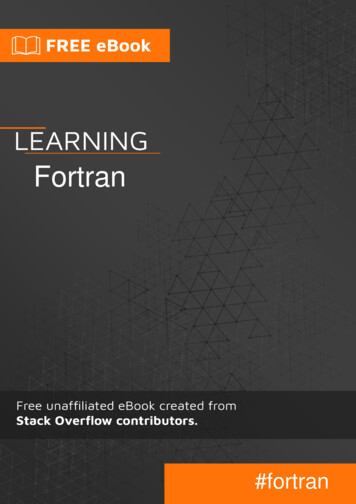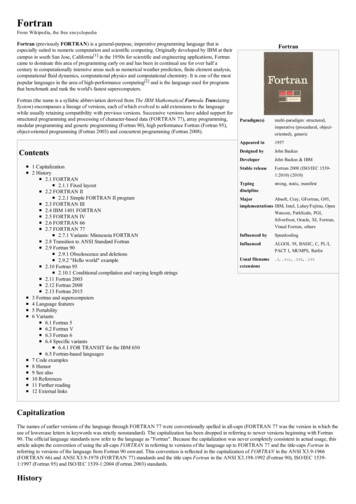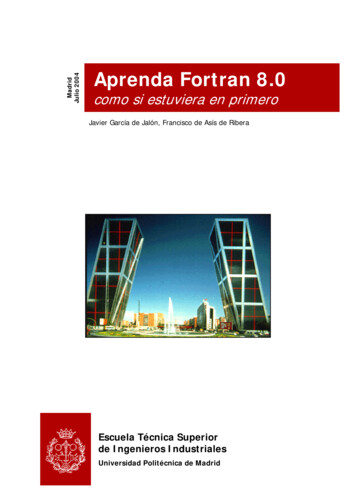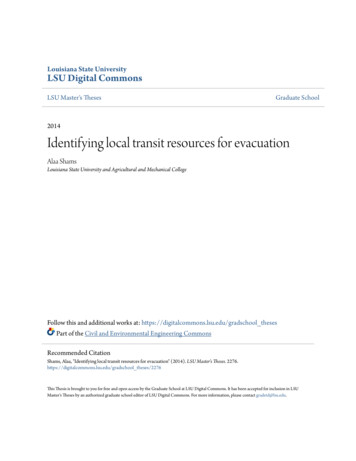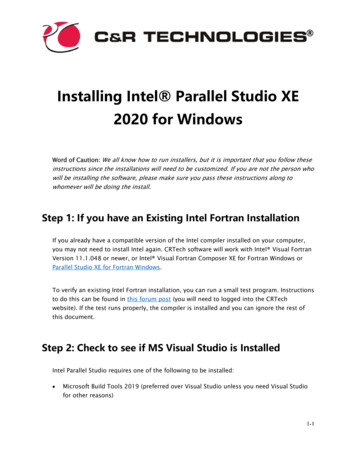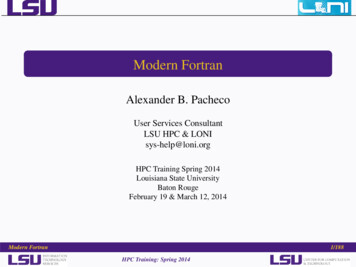
Transcription
Modern FortranAlexander B. PachecoUser Services ConsultantLSU HPC & LONIsys-help@loni.orgHPC Training Spring 2014Louisiana State UniversityBaton RougeFebruary 19 & March 12, 2014Modern Fortran1/188HPC Training: Spring 2014
Tutorial OutlineDay 1: Introduction to Fortran ProgrammingOn the first day, we will provide an introduction to the Fortran90/95 Programming Language. Go to slide 3Day 2: Advanced Concepts in Fortran ProgrammingOn the second day, we will cover advanced topics such asmodules, derived types, interfaces, etc. Go to slide 101Modern Fortran2/188HPC Training: Spring 2014
Part IIntroduction to Fortran ProgrammingModern Fortran3/188HPC Training: Spring 2014
Outline of Part I1Introduction2Basics3Program Structure4Input and Output5Control Constructs6ExerciseModern Fortran4/188HPC Training: Spring 2014
What is Fortran?Fortran is a general-purpose, imperative programming languagethat is especially suited to numeric computation and scientificcomputing.Originally developed by IBM for scientific and engineeringapplications.The name Fortran is derived from The IBM MathematicalFormula Translating System.It was one of the first widely used "high-level" languages, as wellas the first programming language to be standardized.It is still the premier language for scientific and engineeringcomputing applications.Modern Fortran5/188HPC Training: Spring 2014
Many Flavors of FortranFORTRAN — first released by IBM in 1956FORTRAN II — released by IBM in 1958FORTRAN IV — released in 1962, standardizedFORTRAN 66 — appeared in 1966 as an ANSI standardFORTRAN 77 — appeared in 1977, structured featuresFortran 90 — 1992 ANSI standard, free form, modulesFortran 95 — a few extensionsFortran 2003 — object oriented programmingFortran 2008 — a few extensionsThe correct spelling of Fortran for 1992 ANSI standard and later(sometimes called Modern Fortran) is "Fortran". Older standards arespelled as "FORTRAN".Modern Fortran6/188HPC Training: Spring 2014
Why Learn Fortran?Fortran was designed by, and for, people who wanted rawnumber crunching speed.There’s a great deal of legacy code and numerical librarieswritten in Fortran,attempts to rewrite that code in a more "stylish" language resultin programs that just don’t run as fast.Fortran is the primary language for some of the most intensivesupercomputing tasks, such asastronomy,weather and climate modeling,numerical linear algebra and libraries,computational engineering (fluid dynamics),computational science (chemistry, biology, physics),computational economics, etc.How many of you are handed down Fortran code that you areexpected to further develop?Modern Fortran7/188HPC Training: Spring 2014
Why learn Modern Fortran and not FORTRAN?FORTRAN is a fixed source format dating back to the use ofpunch cards.The coding style was very restrictiveMax 72 columns in a line withfirst column reserved for comments indicated by a character suchas c or *,the second through fifth columns reserved for statement labels,the sixth column for continuation indicator, andcolumns 7 through 72 for statements.Variable names can consists of up to 6 alphanumeric characters(a-z,0-9)Cannot process arrays as a whole, need to do it element byelement.Cannot allocate memory dynamically.Modern Fortran8/188HPC Training: Spring 2014
FORTRAN 77 ExampleSAXPY 789012345678901234567890program testinteger nparameter(n 100)real alpha, x(n), y(n)10alpha 2.0do 10 i 1,nx(i) 1.0y(i) 2.0continuecall saxpy(n,alpha,x,y)returnendsubroutine saxpy(n, alpha, x, y)integer nreal alpha, x(*), y(*)cc Saxpy: Compute y : alpha*x y,c where x and y are vectors of length n (at least).cdo 20 i 1, ny(i) alpha*x(i) y(i)20continuereturnendModern Fortran9/188HPC Training: Spring 2014
Why Learn Modern Fortran?Free-format source code with a maximum of 132 characters perline,Variable names can consists of up to 31 alphanumeric characters(a-z,0-9) and underscores ( ),Dynamic memory allocation and Ability to operate on arrays (orarray sections) as a whole,generic names for procedures, optional arguments, calls withkeywords, and many other procedure call options,Recursive procedures and Operator overloading,Structured data or derived types,Object Oriented Programming.See http://en.wikipedia.org/wiki/Fortran#Obsolescence and deletions for obsolete and deletedFORTRAN 77 features in newer standards.Modern Fortran10/188HPC Training: Spring 2014
FORTRAN 90 ExampleSAXPY Codeprogram testimplicit noneinteger, parameter :: n 100real :: alpha, x(n), y(n)alpha 2.0x 1.0y 2.0call saxpy(n,alpha,x,y)end program testsubroutine saxpy(n, alpha, x, y)implicit noneinteger :: nreal :: alpha, x(*), y(*)!! Saxpy: Compute y : alpha*x y,! where x and y are vectors of length n (at least).!y(1:n) alpha*x(1:n) y(1:n)end subroutine saxpyModern Fortran11/188HPC Training: Spring 2014
Major Differences with CNo standard libraries: No specific libraries have to be loadedexplicitly for I/O and math.Implicit type declaration: In Fortran, variables of type real andinteger may be declared implicitly, based on their first letter. Thisbehaviour is not recommended in Modern Fortran.Arrays vs Pointers: Multi-dimension arrays are supported(arrays in C are one-dimensional) and therefore no vector orarray of pointers to rows of a matrices have to be constructed.Call by reference: Parameters in function and subroutine callsare all passed by reference. When a variable from the parameterlist is manipulated, the data stored at that address is changed, notthe address itself. Therefore there is no reason for referencingand de-referencing of addresses (as commonly seen in C).Modern Fortran12/188HPC Training: Spring 2014
Fortran Source Code IFortran source code is in ASCII text and can be written in anyplain-text editor such as vi, emacs, etc.For readability and visualization use a text editor capable ofsyntax highlighting and source code indentation.Fortran source code is case insensitive i.e. PROGRAM is thesame as Program.Using mixed case for statements and variables is not considereda good programming practice. Be considerate to yourcollaborators who will be modifying the code.Some Programmers use uppercase letters for Fortran keywordswith rest of the code in lowercase while others (like me) only uselower case letters.Use whatever convention you are comfortable with and beconsistent throughout.Modern Fortran13/188HPC Training: Spring 2014
Fortran Source Code IIThe general structure of a Fortran program is as followsPROGRAM nameIMPLICIT NONE[specification part][execution part][subprogram part]END PROGRAM name123456A Fortran program starts with the keyword PROGRAM followed byprogram name,This is followed by the IMPLICIT NONE statement (avoid use ofimplicit type declaration in Fortran 90),Followed by specification statements for various typedeclarations,Followed by the actual execution statements for the program,Any optional subprogram, and lastlyThe END PROGRAM statementModern Fortran14/188HPC Training: Spring 2014
Fortran Source Code IIIA Fortran program consists of one or more program units.PROGRAMSUBROUTINEFUNCTIONMODULEThe unit containing the PROGRAM attribute is often called the mainprogram or main.The main program should begin with the PROGRAM keyword. Thisis however not required, but it’s use if highly recommended.A Fortran program should contain only one main program i.e.one PROGRAM keyword and can contain one or more subprogramunits such as SUBROUTINE, FUNCTION and MODULE.Every program unit, must end with a END keyword.Modern Fortran15/188HPC Training: Spring 2014
Simple I/OAny program needs to be able to read input and write output tobe useful and portable.In Fortran, the print command provides the most simple formof writing to standard output while,the read command provides the most simple form of readinginput from standard inputprint *, var1 [, var2 [, . ]]read *, var1 [, var2 [, . ]]The indicates that the format of data read/written isunformatted.In later sections, we will cover how to read/write formatted dataand file operations.variables to be read or written should be separated by a comma(,).Modern Fortran16/188HPC Training: Spring 2014
Your first code in FortranOpen a text editor and create a file helloworld.f90 containing thefollowing linesprogram helloprint *, ’Hello World!’end program helloThe standard extension for Fortran source files is .f90, i.e., thesource files are named name .f90.The .f extension implies fixed format source or FORTRAN 77code.Modern Fortran17/188HPC Training: Spring 2014
Compiling Fortran CodeTo execute a Fortran program, you need to compile it to obtainan executable.Almost all *NIX system come with GCC compiler installed. Youmight need to install the Fortran (gfortran) compiler if its notpresent.Command to compile a fortran program compiler [flags] [-o executable] source code The [.] is optional. If you do not specify an executable, then thedefault executable is a.outaltair:Exercise apacheco gfortran helloworld.f90altair:Exercise apacheco ./a.outHello World!Other compilers available on our clusters are Intel (ifort),Portland Group (pgf90) and IBM XL (xlf90) compilers.ifort -o helloworld helloworld.f90; ./helloworldModern Fortran18/188HPC Training: Spring 2014
CommentsTo improve readability of the code, comments should be usedliberally.A comment is identified by an exclamation mark or bang (!),except in a character string.All characters after ! upto the end of line is a comment.Comments can be inline and should not have any Fortranstatements following itprogram hello! A simple Hello World codeprint *, ’Hello World!’ ! Print Hello World to screen! This is an incorrect comment if you want Hello World to printto screen ! print *, ’Hello World!’end program helloModern Fortran19/188HPC Training: Spring 2014
Variables IVariables are the fundamental building blocks of any program.In Fortran, a variable name may consist of up to 31 alphanumericcharacters and underscores, of which the first character must be aletter.There are no reserved words in Fortran.However, names must begin with a letter and should not containa space.Allowed names: a, compute force, qed123Invalid names: 1a, a thing, signModern Fortran20/188HPC Training: Spring 2014
Variables IIVariable TypesFortran provides five intrinsic data typesINTEGER: exact whole numbersREAL: real, fractional numbersCOMPLEX: complex, fractional numbersLOGICAL: boolean valuesCHARACTER: stringsand allows users to define additional types.The REAL type is a single-precision floating-point number.The COMPLEX type consists of two reals (most compilers alsoprovide a DOUBLE COMPLEX type).FORTRAN also provides DOUBLE PRECISION data type fordouble precision REAL. This is obsolete but is still found inseveral programs.Modern Fortran21/188HPC Training: Spring 2014
Variables IIIExplicit and Implicit TypingFor historical reasons, Fortran is capable of implicit typing ofvariables.IN T EGERz } {U V W XY ZABCDEF{z GH} IJKLM N OP QRST{z }REALREALYou might come across old FORTRAN program containingIMPLICIT REAL*8(a-h,o-z) orIMPLICIT DOUBLE PRECISION (a-h,o-z).It is highly recommended to explicitly declare all variable andavoid implict typing using the statement IMPLICIT NONE.The IMPLICIT statement must precede all variable declarations.Modern Fortran22/188HPC Training: Spring 2014
Literal Constants IConstants are literal representation of a type that are specified bya programmer.In Fortran, different constant formats are required for each type.IntegerIntegers are specified by a number without a decimal point,may contain an optional sign, andnot contain commasExample137-5678900123Modern Fortran23/188HPC Training: Spring 2014
Literal Constants IIRealReals (single precision) may be specified by adding a decimalpoint, or by using scientific notation with the letter e indicatingthe exponent.Examples19.3.141596.023e23Double precision constants must be specified in the expontentnotation with the letter d indicating the exponentExamples23d06.626d-34-3.14159d0Modern Fortran24/188HPC Training: Spring 2014
Literal Constants IIIComplexComplex constants consist of two single-precision constantsenclosed in parenthesis.The first constant is the real part; the second is the imaginary part.Example(1.0,0.0)(-2.7e4,5.0)For systems that support double precision complex, the floatingpoint constants must use the d notation.(-2.7d-4,5.d0)LogicalLogical constants can take only the value .True. or .FALSE.with the periods part of the constant.Modern Fortran25/188HPC Training: Spring 2014
Literal Constants IVCharacterCharacter constants are specified by enclosing them in single quotes.Example’This is a character constant’’The value of pi is 3.1415’If an apostrophe is to be part of the constant, it should be represented bya double quote’All the world’’s a stage’Modern Fortran26/188HPC Training: Spring 2014
Variable Declarations IVariables must be declared before they can be used.In Fortran, variable declarations must precede all executablestatements.To declare a variable, preface its name by its type.TYPE VariableA double colon may follow the type.TYPE[, attributes] :: VariableThis is the new form and is recommended for all declarations. Ifattributes need to be added to the type, the double colon formatmust be used.A variable can be assigned a value at its declaration.Modern Fortran27/188HPC Training: Spring 2014
Variable Declarations IINumeric Variables:INTEGER :: i, j 2REAL:: a, b 4.d0COMPLEX :: x, yIn the above examples, the value of j and b are set at compiletime and can be changed later.If you want the assigned value to be constant that cannot changesubsequently, add the attribute PARAMETERINTEGER, PARAMETER :: j 2REAL, PARAMETER:: pi 3.14159265COMPLEX, PARAMETER :: ci (0.d0,1.d0)Logical: Logical variables are declared with the LOGICALkeywordLOGICAL:: l, flag .true.Modern Fortran28/188HPC Training: Spring 2014
Variable Declarations IIICharacter: Character variables are declared with the CHARACTERtype; the length is supplied via the keyword LEN.The length is the maximum number of characters (includingspace) that will be stored in the character variable.If the LEN keyword is not specified, then by default LEN 1 andonly the first character is saved in memory.CHARACTER:: ans ’yes’ ! stored as y not yesCHARACTER(LEN 10) :: aFORTRAN programmers: avoid the use of CHARACTER*10notation.Modern Fortran29/188HPC Training: Spring 2014
Array VariablesArrays (or matrices) hold a collection of different values at thesame time.Individual elements are accessed by subscripting the array.Arrays are declared by adding the DIMENSION attribute to thevariable type declaration which can be integer, real, complex orcharacter.Usage: TYPE, DIMENSION(lbound:ubound):: variable nameLower bounds of one can be omittedINTEGER, DIMENSION(1:106) :: atomic numberREAL, DIMENSION(3, 0:5, -10:10) :: valuesCHARACTER(LEN 3), DIMENSION(12) :: monthsIn Fortran, arrays can have upto seven dimension.In contrast to C/C , Fortran arrays are column major.We’ll discuss arrays in more details in the Advanced ConceptsTutorials.Modern Fortran30/188HPC Training: Spring 2014
DATA StatmentsIn FORTRAN, a DATA statement may be used to initialize avariable or group of variables.It causes the compiler to load the initial values into the variablesat compile time i.e. a nonexecutable statmentGeneral formDATA varlist /varlist/ [, varlist /varlist/]Example DATA a,b,c /1.,2.,3./statements can be used in Fortran but it is recommended toto eliminate this statement by initializing variables in theirdeclarations.DATAIn Fortran 2003, variables may be initialized with intrinsicfunctions (some compilers enable this in Fortran 95)REAL, PARAMETER :: pi 4.0*atan(1.0)Modern Fortran31/188HPC Training: Spring 2014
KIND Parameter IIn FORTRAN, types could be specified with the number of bytesto be used for storing the value:real*4 - uses 4 bytes, roughly 10 38 to 1038 .real*8 - uses 8 bytes, roughly 10 308 to 10308 .complex*16 - uses 16 bytes, which is two real*8 numbers.Fortran 90 introduced kind parameters to parameterize theselection of different possible machine representations for eachintrinsic data types.The kind parameter is an integer which is processor dependent.There are only 2(3) kinds of reals: 4-byte, 8-byte (and 16-byte),respectively known as single, double (and quadruple) precision.The corresponding kind numbers are 4, 8 and 16 (mostcompilers)Modern Fortran32/188HPC Training: Spring 2014
KIND Parameter IIKIND124a816aSize (Bytes)124816Data Typeinteger, logical, character (default)integer, logicalinteger, real, logical, complexinteger, real, logical, complexreal, complexdefault for all data types except characterYou might come across FORTRAN codes with variabledeclarations using integer*4, real*8 and complex*16corresponding to kind 4 (integer) and kind 8 (real andcomplex).The value of the kind parameter is usually not the number ofdecimal digits of precision or range; on many systems, it is thenumber of bytes used to represent the value.Modern Fortran33/188HPC Training: Spring 2014
KIND Parameter IIIThe intrinsic functions selected int kind andselected real kind may be used to select an appropriate kindfor a variable or named constant.returns the kind value of the smallestinteger type that can represent all values ranging from 10R(exclusive) to 10R (exclusive)selected int kind(R)returns the kind value of a real datatype with decimal precision of at least P digits, exponent rangeof at least R. At least one of P and R must be specified, default Ris 308.selected real kind(P,R)Modern Fortran34/188HPC Training: Spring 2014
KIND Parameter IVprogram kind functionimplicit noneinteger,parameter :: dp selected real kind(15)integer,parameter :: ip selected int kind(15)integer(kind 4) :: iinteger(kind 8) :: jinteger(ip) :: kreal(kind 4) :: areal(kind 8) :: breal(dp) :: c’(a,i2,a,i4)’, ’Kind of i ’,kind(i), ’ with range ’, range(i)’(a,i2,a,i4)’, ’Kind of j ’,kind(j), ’ with range ’, range(j)’(a,i2,a,i4)’, ’Kind of k ’,kind(k), ’ with range ’, range(k)’(a,i2,a,i2,a,i4)’, ’Kind of real a ’,kind(a),&’ with precision ’, precision(a),&’ and range ’, range(a)print ’(a,i2,a,i2,a,i4)’, ’Kind of real b ’,kind(b),&’ with precision ’, precision(b),&’ and range ’, range(b)print ’(a,i2,a,i2,a,i4)’, ’Kind of real c ’,kind(c),&’ with precision ’, precision(c),&’ and range ’, range(c)print *, huge(i),kind(i)print *, huge(j),kind(j)print *, huge(k),kind(k)printprintprintprintend program kind functionModern Fortran35/188HPC Training: Spring 2014
KIND Parameter V[apacheco@qb4 Exercise] ./kindfnsKind of i 4 with range 9Kind of j 8 with range 18Kind of k 8 with range 18Kind of real a 4 with precision 6Kind of real b 8 with precision 15Kind of real c 8 with precision 15and range 37and range 307and range 307Modern Fortran36/188HPC Training: Spring 2014
Operators and ExpressionsFortran defines a number of operations on each data type.Arithmetic OperatorsRelational Operators (FORTRAN versions) : addition : equal to (.eq.)- : subtraction/ : not equal to (.ne.)* : multiplication : less than (.lt.)/ : division : less than or equal to (.le.)** : exponentiation : greater than (.gt.) : greater than or equal to (.ge.)Logical ExpressionsCharacter Operators.AND. intersection// : concatenation.OR. union.NOT. negation.EQV. logical equivalence.NEQV. exclusive orModern Fortran37/188HPC Training: Spring 2014
Operator Evaluations IIn Fortran, all operator evaluations on variables is carried outfrom left-to-right.Arithmetic operators have a highest precedence while logicaloperators have the lowest precedenceThe order of operator precedence can be changed usingparenthesis, ’(’ and ’)’In Fortran, a user can define his/her own operators.User defined monadic operator has a higher precedence thanarithmetic operators, whiledyadic operators has a lowest precedence than logical operators.Modern Fortran38/188HPC Training: Spring 2014
Operator Evaluations IIOperator PrecedenceOperatorexpression in ()user-defined monadic*** or /monadic or dyadic or //relational operators.not.and.or.eqv. or .neqv.user defined dyadicPrecedenceHighestLowestModern FortranExample(a b).inverse.a10**410*20-51 5str1//str2a 8HPC Training: Spring 2014
ExpressionsAn expression is a combination of one or more operands, zero ormore operators, and zero or more pairs of parentheses.There are three kinds of expressions:An arithmetic expression evaluates to a single arithmetic value.A character expression evaluates to a single value of typecharacter.A logical or relational expression evaluates to a single logicalvalue.Examples:x 1.097.4d0sin(y)x*aimag(cos(z w))a .and. b’AB’ // ’wxy’Modern Fortran40/188HPC Training: Spring 2014
Statements IA statement is a complete instruction.Statements may be classified into two types: executable andnon-executable.Non-executable statements are those that the compiler uses todetermine various fixed parameters such as module usestatements, variable declarations, function interfaces, and dataloaded at compile time.Executable statements are those which are executed at runtime.A statements is normally terminated by the end-of-line marker.If a statement is too long, it may be continued by the ending theline with an ampersand (&).Modern Fortran41/188HPC Training: Spring 2014
Statements IIMax number of characters (including spaces) in a line is 132though it’s standard practice to have a line with up to 80characters. This makes it easier for file editors to display code orprint code on paper for reading.Multiple statements can be written on the same line provided thestatements are separated by a semicolon.Examples:force 0d0 ; pener 0d0do k 1, 3r(k) coord(i,k) - coord(j,k)Assignment statements assign an expression to a quantity usingthe equals sign ( )The left hand side of the assignment statement must contain asingle variable.x 1.0 y is not a valid assignment statement.Modern Fortran42/188HPC Training: Spring 2014
Intrinsic FunctionsFortran provide a large set of intrinsic functions to implement awide range of mathematical operations.In FORTRAN code, you may come across intrinsic functionswhich are prefixed with i for integer variables, d for doubleprecision, c for complex single precision and cd for complexdouble precision variables.In Modern Fortran, these functions are overloaded, i.e. they cancarry out different operations depending on the data type. 2For example: the abs function equates to a for integer andreal numbers and 2 2 for complex numbers.Modern Fortran43/188HPC Training: Spring 2014
Arithmetic NGFLOORMAXMINSQRTEXPLOGLOG10aActionconversion to integerconversion to realreturn real part of complex numberconvert to double precisionconversion to complexreturn imaginary part of complex numberabsolute valueremainder when I divided by Jsmallest integer to argumentlargest integer to argumentmaximum of list of argumentsminimum of list of argumentssquare rootexponentiationnatural logarithmlogarithm to base 10ExampleJ INT(X)X REAL(J)X REAL(Z)X DBLE(J)A CMPLX(X[,Y])Y AIMAG(Z)Y ABS(X)K MOD(I,J)I CEILING(a)I FLOOR(a)A MAX(C,D)A MIN(C,D)Y SQRT(X)Y EXP(X)Y LOG(X)Y LOG10(X)use real(x,kind 8) insteadModern Fortran44/188HPC Training: Spring 2014
Trignometric gentarctangent(a/b)hyperbolic sinehyperbolic cosinehyperbolic tangentExampleX SIN(Y)X COS(Y)X TAN(Y)X ASIN(Y)X ACOS(Y)X ATAN(Y)X ATAN2(A,B)X SINH(Y)X COSH(Y)X TANH(Y)hyperbolic functions are not defined for complex argumentModern Fortran45/188HPC Training: Spring 2014
Character Functionslen(c)len length of c if it were trimmedreturns .true. if s1 follows or is equal to s2 in lexical orderreturns .true. if s1 follows s1 in lexical orderreturns .true. if s2 follows or is equal to s1 in lexical orderreturns .true. if s2 follows s1 in lexical orderreturns string with leading blanks removed andsame number of trailing blanks addedreturns string with trailing blanks removed andsame number of leading blanks addedconcatenates string s to itself n timesreturns the integer starting position of string c within string strim trailing blanks from cModern Fortran46/188HPC Training: Spring 2014
Array Intrinsic Functionssize(x[,n]) The size of x (along the nth dimension, optional)sum(x[,n]) The sum of all elements of x (along the nth dimension, optional)Psum(x) i,j,k,··· xi,j,k,···product(x[,n]) The product of all elements of x (along the nth dimension, optional)Qprod(x) i,j,k,··· xi,j,k,···transpose(x) Transpose of array x: xi,j xj,iPdot product(x,y) Dot Product of arrays x and y: i xi yimatmul(x,y) Matrix Multiplication of arraysP x and y which can be 1 or 2dimensional arrays: zi,j k xi,k yk,jconjg(x) Returns the conjugate of x: a ıb a ıbModern Fortran47/188HPC Training: Spring 2014
Program Structure IPROGRAM program-nameIMPLICIT NONE[specification part][execution part][subprogram part]END PROGRAM program-nameAll Fortran statements are case insensitive.Most programmers use lower case letters with upper case lettersreserved for program keywords.Are you a FORTRAN 77 or older programmer?Use the IMPLICIT NONE statement, avoidimplicit real*8(a-h,o-z) statement. Get in the habit ofdeclaring all variables.Modern Fortran48/188HPC Training: Spring 2014
Simple Temperature Conversion ProblemWrite a simple program that12Converts temperature from celsius to fahrenheitConverts temperature from fahrenheit to celsiusprogram tempaltair:Exercise apacheco gfortran simple.f90altair:Exercise apacheco ./a.out10C 42.0000000F40F 0.00000000Cimplicit nonereal :: tempC, tempF! Convert 10C to fahrenheittempF 9 / 5 * 10 32! Convert 40F to celsiustempC 5 / 9 * (40 - 32 )print *, ’10C ’, tempF, ’F’print *, ’40F ’, tempC, ’C’end program tempSo what went wrong? 10C 50F and 40F 4.4CModern Fortran49/188HPC Training: Spring 2014
Type Conversion IIn computer programming, operations on variables and constantsreturn a result of the same type.In the temperature code, 9/5 1 and 5/9 0. Divisionbetween integers is an integer with the fractional part truncated.In the case of operations between mixed variable types, thevariable with lower rank is promoted to the highest rank type.Variable 1IntegerIntegerRealRealVariable 2RealComplexDouble PrecisionComplexModern FortranResultRealComplexDouble PrecisionComplex50/188HPC Training: Spring 2014
Type Conversion IIAs a programmer, you need to make sure that the expressionstake type conversion into accountprogram tempaltair:Exercise apacheco gfortran temp.f90altair:Exercise apacheco ./a.out10C 50.0000000F40F 4.44444466Cimplicit nonereal :: tempC, tempF! Convert 10C to fahrenhiettempF 9. / 5. * 10 32! Convert 40F to celsiustempC 5. / 9. * (40 - 32 )print *, ’10C ’, tempF, ’F’print *, ’40F ’, tempC, ’C’end program tempThe above example is not a good programming practice.10, 40 and 32 should be written as real numbers (10., 40. and32.) to stay consistent.Modern Fortran51/188HPC Training: Spring 2014
Input and Output Descriptors IInput and output are accomplished by operations on files.Files are identified by some form of file handle, in Fortran calledthe unit number.We have already encountered read and write command such asprint *, and read *,Alternative commands for read and write areread(unit,*)write(unit,*)There is no comma after the ’)’. FORTRAN allowed statementsof the form write(unit,*), which is not supported on somecompilers such as IBM XLF. Please avoid this notation inFORTRAN programs.The default unit number 5 is associated with the standard input,andModern Fortran52/188HPC Training: Spring 2014
Input and Output Descriptors IIunit number 6 is assigned to standard output.You can replace unit with ? in which case standard input (5) andoutput (6) file descriptors are used.The second ? in read/write or the one in the print */read *corresponds to unformatted input/output.If I/O is formatted, then ? is replaced withfmt format specifier Modern Fortran53/188HPC Training: Spring 2014
File Operations IA file may be opened with the statementOPEN([UNIT ]un, FILE fname [, options])Commonly used options for the open statement are:IOSTAT ios:This option returns an integer ios; its value is zeroif the statement executed without error, and nonzero if an erroroccured.ERR label:label is the label of a statement in the same programunit. In the event of an error, execution is transferred to thislabelled statement.STATUS istat: This option indicates the type of file to beopened. Possible values are:old : the file specified by the file parameter must exist.new : the file will be created and must not exist.Modern Fortran54/188HPC Training: Spring 2014
File Operations IIreplace : the file will be created if it does not exist or if it exists, the filewill be deleted and created i.e. contents overwritten.unknown : the file will be created if it doesn’t exist or opened if it existswithout further processing.scratch : file will exist until the termination of the executing program oruntil a close is executed on that unit.position todo: This options specifies the position where theread/write marker should be placed when opened. Possiblevalues are:rewind : positions the file at its initial point. Convenient for rereadingdata from file such as input parameters.append : positions the file just before the endfile record. Convenientwhile writing to a file that already exists. If the
LSU HPC & LONI sys-help@loni.org HPC Training Spring 2014 Louisiana State University Baton Rouge February 19 & March 12, 2014 Modern Fortran 1/188 HPC Training: Spring 2014. Tutorial Outline Day 1: Introduction to Fortran Programming On the first day, we will provide an introduction to the Fortran
